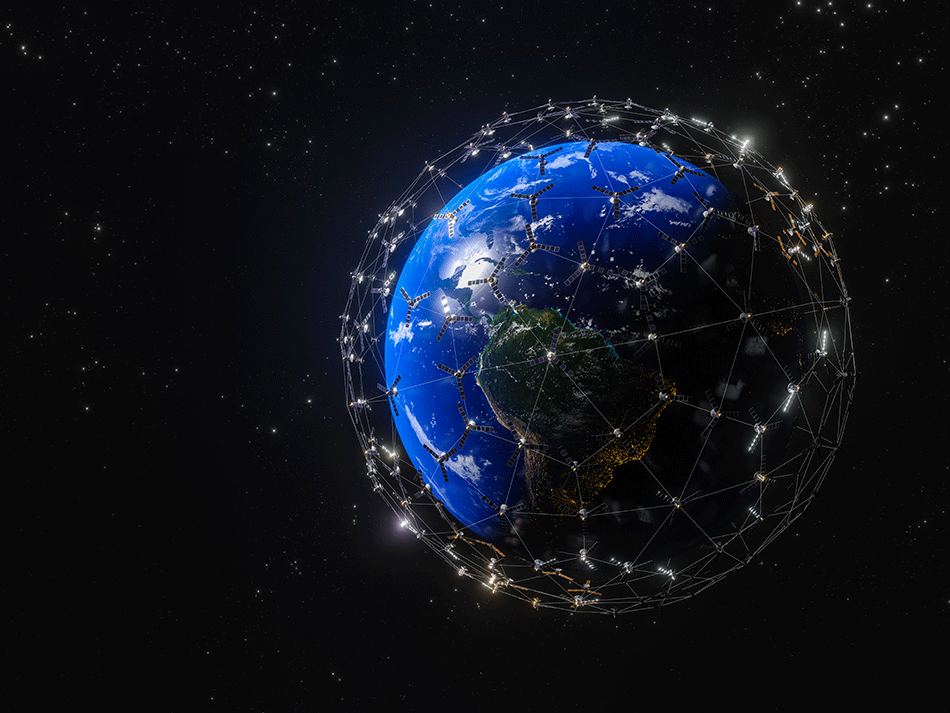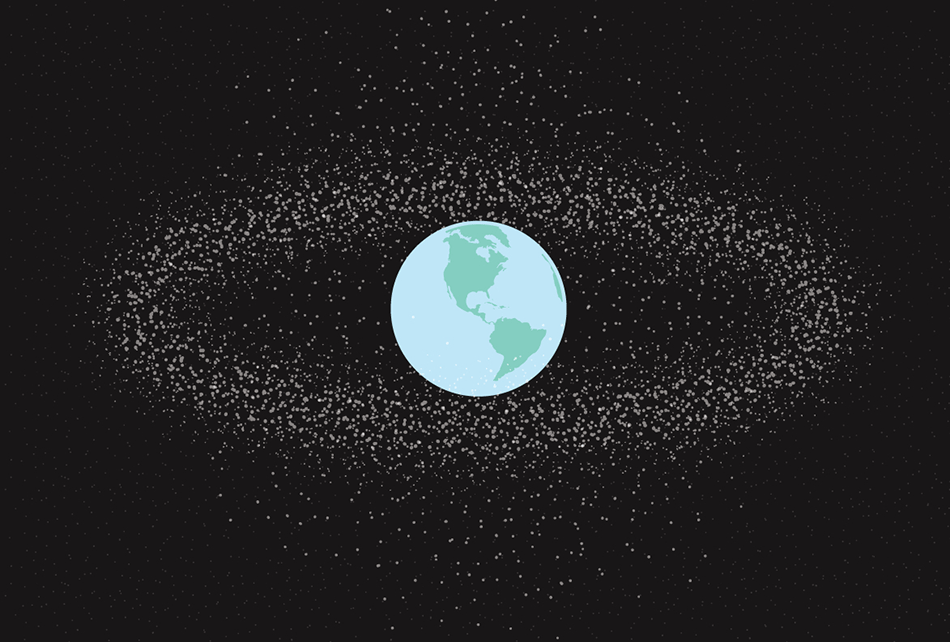By Shruti Shalini, Shalabh Kumar Singh, and Shubhashis Sengupta
Space-to-Earth observation technologies are helping businesses and governments make progress towards realizing sustainable development goals on Earth. Now they need to make sure they’re not harming the space environment in the process.
KEY TAKEAWAYS
- The deregulation of the space sector has incentivized a thriving, technology-led
space-to-Earth Observation economy, accelerating space-led innovation across sectors. - The precision and granularity of Earth Observation intelligence and analytics is particularly useful to drive sustainability initiatives in areas such as climate action, clean energy, urban planning, and food security.
- To make the most of these technologies, it’s important to address the problem of rising space junk with effective design principles, technological innovation, better dialog and ecosystem collaboration.
Space technologies are improving lives on Earth in profound ways, from assessing damages from wildfires in Spain to facilitating urban planning in Italy to extending connectivity in Ukraine. While the term ‘space technology’ encapsulates several things, space-to-Earth observation—or simply Earth Observation (EO) – technologies have become increasingly important for businesses in recent years.
EO technologies encompass a set of remote sensing techniques that use satellite imagery and other sensor data to capture insights about the Earth. The European Union’s Copernicus program is a good example. A set of systems collect data from multiple sources including EO satellites, in-situ ground stations, and airborne and sea-borne sensors for services like rapid assessment of extreme weather events.1
The potential of space-to-Earth technology for boosting business growth and innovation is now at an inflection point due to the deregulation of the space sector.2 The UN Office for Outer Space Affairs (UNOOSA) received registration of over 2000 satellites in 2022, and the expectation is that 100,000 satellites could be launched in the next decade.3
This democratization of space is opening new opportunities for specialized Earth analytics capabilities, which combine advances in AI algorithms with open and free or cost-effective access to data. For example, Titan Space Technologies – a platform built on a sophisticated suite of applied AI capabilities – recently launched its first AI models to the International Space Station (ISS) for designing space-led experimentation and innovation projects across several sectors.4
Such advances are particularly important for boosting action towards achieving the UN sustainable development goals (SDGs). Of the 16 market segments identified by the European Union Agency for the Space Programme (EUSPA) where EO applications play an important role,5 12 relate directly to advancing sustainability initiatives on Earth.
Two characteristics of EO data are particularly useful for advancing sustainability measures:
- It can regularly capture granular and precise information, nearly impossible to obtain and scale with land-based survey techniques
- It allows blending raw EO data and imagery with global navigation satellite systems (GNSS) and global information systems (GIS) to gain actionable information and intelligence
However, even as this important work advances, concerns are growing about protecting the space environment itself. The rising number of satellites in outer space is leading to a heavy accumulation of space debris. In the rest of this article, we discuss both:the sustainability potential of EO for driving business and government action towards SDGs, as well as the need for a sustainable space ecosystem.
Environment & climate action

Space technologies help quantify changes in climate systems over time—from increasing surface temperatures to melting ice sheets and rising sea-levels. The 4Vs of EO data – volume, variety, veracity, and velocity – make it particularly suitable for climate change research and action.6 The unprecedented regularity and granularity of data from remote sensing is helping governments and businesses build early warning systems for climate resilience.7
Accenture has partnered with Planet Labs, a provider of Earth data and insights, to combine high-frequency satellite imagery with Accenture’s sustainability services. This will enable an array of sustainability initiatives, including data-based climate-risk assessments. High-frequency satellite imagery is said to contribute significantly to sustainability initiatives ranging from sustainable agriculture and energy transformation to supply chain tracking and sourcing.8
Sustainable and clean energy

Satellite imagery and analytics can help monitor energy generation and usage in real-time and assess its impact on the environment. This enables customized energy-saving plans, optimized energy costs, improved energy efficiency, and lower carbon emissions.
In collaboration with Duke Energy, Microsoft and Avanade, Accenture has created a first-of-its-kind methane emissions monitoring platform, allowing companies to move to a “find it, fix it” leak management model and to measure actual baseline methane emissions from natural gas distribution systems. This cloud-hosted platform will track data related to leaks using advanced detection methods such as satellites and ground-level sensing technology that can detect trace levels of methane emissions on priority. This collaboration will augment Duke Energy’s drive toward net-zero methane emissions by 2030.9
Economic growth & urban planning

Satellite imagery, coupled with mobile communications and social media platforms with geotagging technology, could become an important tool in urban design and development. Satellite-based data is more effective than aerial surveys to monitor changes in land use, aiding city planners in designing sustainable cities.
Italian company Planetek’s ground motion service called Rheticus utilizes satellite imagery to provide regular data on nation-wide maps of ground movement. This data is being used by the Italian Roads Authority to detect and monitor unexpected ground movements as the country is prone to landslides, subsidence, and earthquakes. Continuous tracking of such data is allowing road planners in Italy to identify the risks that pose significant challenges in infrastructure maintenance and helping them build a stable and resilient roadway.10
Agriculture & food security
Remote sensing, combined with advanced GIS data processing and visualization technologies, can help businesses promote the adoption of innovative practices, such as precision agriculture, farm automation, and real-time kinematic technology to mitigate risks to global food systems. The UNOOSA estimates that precision agriculture using EO and GNSS data can attain yield increases of over 10%, and lower other fuel, fertilizer, and pesticide inputs by up to 20%.11
The SAGRIS project, funded by the EU, is an open-source smart farming decision support back-end service. It continuously pulls synthetic-aperture radar (SAR) images to create sophisticated dynamic images and data layers at different temporal scales to inform the identification, monitoring and development of crop types during the farming season. SAGRIS analyzes satellite imagery from the Copernicus EO programme to provide per-parcel sampling data for various smart farming applications and for applied research in various streams.12
The Food Security and Agricultural Monitoring Solution recently launched by NASA Harvest uses AI and ML modelling to convert satellite data into insights for anticipating and averting food shortages and famines. The pilot was first launched in 2022 to track frontline agricultural activity in Ukraine.13
Towards a sustainable space ecosystem
The European Space Agency has cataloged more than 36,500 objects larger than 10 cm currently orbiting Earth, along with millions of pieces smaller than 1 cm.14 More than 80 countries currently contribute to the over 6,800 active satellites in orbit.15 With UNOOSA’s estimates of 70–90 spacecrafts being sent to orbit every year,16 the problem of “space junk” is only likely to get worse.
Removing debris from space and abating the creation of new debris are two major concerns that need to be addressed on priority. However, no one institution can achieve this on its own. Shared responsibilities between governments, private organizations, and non-profit entities towards common goals and measurable targets is needed to build a sustainable space ecosystem. Three actions can help begin the jouney:
1. Design for sustainability
Advances in material science are promoting the use of light metal alloys and light metals such as aluminum in rocket design, promoting longevity and sustainability of space operations. Alongside, initiatives such as the Space Sustainability Rating (SSR) by the World Economic Forum in partnership with several academic and institutional partners, are encouraging companies to adopt holistically sustainable design principles right from inception. The rating system relies on multiple factors—from data sharing and orbit preferences to collision avoidance and de-orbiting satellites—to assess the sustainability of space missions and operations. By voluntarily adopting the SSR system, different players in the space ecosystem can secure one of the four levels of certification to disclose their mission’s sustainability.17
2. Explore the use of new technologies

Technologies like space situational awareness (SSA) can help in data analysis, integration, and evaluation of key space events, including re-entering objects, conjunction and collision avoidance activities, fragmentation, satellite maneuver detection and compliance monitoring. Digantara, a space tech start-up, has launched India’s first-ever commercial SSA observatory to monitor global space traffic for space debris. The observatory will likely help reduce collisions between satellites and other spacecraft by predicting their location, speed and trajectory.18 Generative AI could have an important role in developing lighter spacecraft and mission hardware, as recently demonstrated by NASA. Called Evolved Structures, these parts weigh less, can bear higher loads and significantly reduce the time to production.19
3. Partner and collaborate

The Net Zero Space initiative by the Paris Peace Forum is a platform that aims to achieve sustainable use of outer space by 2030. The initiative aims to raise awareness and promote interoperability to drive a sustainable space environment through political and public advocacy and actionable policy proposals. The initiative currently has 59 members from across the space ecosystem and from 24 countries.20
Democratization of space is opening completely new opportunities for businesses. Its impact will likely be felt most on driving sustainability initiatives for achieving the UN SDGs. But care must be taken to ensure that we do not end up compromising the sustainability of space. As a first step, businesses need to explore how EO can help them achieve their sustainability goals and targets. They will also likely need to build an ecosystem around it for innovative use of digital technologies to convert data into insights. Ecosystem play will also be essential for extending the life of space. Space will likely continue to impact and improve sustainable living on Earth, but the space environment must be preserved too.
The authors would like to thank Aditi Abhijeet for her research support.
About the Authors
 Shruti Shalini is thought leadership senior principal and research lead for technology incubation at Accenture.
Shruti Shalini is thought leadership senior principal and research lead for technology incubation at Accenture.
 Shalabh Kumar Singh is principal director and the global lead for sustainable technology and cloud-related thought leadership at Accenture.
Shalabh Kumar Singh is principal director and the global lead for sustainable technology and cloud-related thought leadership at Accenture.
 Shubhashis Sengupta is managing director and APAC technology innovation lead at Accenture.
Shubhashis Sengupta is managing director and APAC technology innovation lead at Accenture.
Endnotes
- The European Union Agency for the Space Programme (EUSPA), “What is Earth Observation,” May 17, 2021
- Matthew Weinzierl, Prithwiraj (Raj) Choudhury, Tarun Khanna, Alan MacCormack, and Brendan Rosseau, “Your Company Needs a Space Strategy. Now.”, Harvard Business Review, November-December 2022, https://hbr.org/2022/11/your-company-needs-a-space-strategy-now.
- The United Nations Office for Outer Space Affairs, “UN Office for Outer Space Affairs and United Kingdom launch new partnership on Registering Space Objects”, December 01, 2022
- Accenture, “Accenture Invests in Titan Space Technologies to Help Unlock the Next Frontier of Innovation through Space Experimentation,” April 06, 2022
- The European Union Agency for the Space Programme (EUSPA), “EO and GNSS Market Report,” 2022
- Guo Hua-Dong, Li Zhang, and Lanwei Zhu, “Earth observation big data for climate change research,” ResearchGate, October, 2015
- Sanjay Podder, Shalabh Kumar Singh, H. James Wilson and Giju Mathew, “Sounding the Alarm: Early Warning Systems to Build Nature-Positive and Climate Resilient Businesses,” The European Business Review, January 30, 2023
- Accenture, “Accenture and Planet to Collaborate on AI-Powered Geospatial Intelligence Tools for Sustainability, Traceable Supply Chain and Climate Risk Solutions,” December 06, 2022
- Accenture, “Duke Energy Teams with Accenture and Microsoft to Develop First-of-its-Kind Methane-Emissions-Monitoring Platform,” August 23, 2021
- The European Space Agency, “Satellite data used for road infrastructure safety in Italy” February 16, 2023
- The United Nations Office for Outer Space Affairs “Sustainable Development Goal 1: No Poverty,” March 31, 2023
- European Commission CORDIS, “Sentinels-based Agriculture Information Service Component,” September 03, 2018
- GreenStockNews, “Planet Labs and NASA Harvest Launch Commercial Partnership to Enable and Advance Food Security Offering to Deliver Policy-Grade Agricultural Assessments“, January 12, 2023
- The European Space Agency, “Space debris by the numbers”, last updated December 22, 2022
- Observer Research Foundation, “Sustainability in Space”, October 11, 2022
- Interesting Engineering, “The Growing Problem of Space Debris,” August 19, 2021
- World Economic Forum, “New Space Sustainability Rating Addresses Space Debris with Mission Certification System,” June 17, 2021
- Outlook India, “Uttarakhand Gets India’s First Ever Commercial Space Situational Awareness Observatory,” August 31, 2022
- NASA, “NASA Turns to AI to Design Mission Hardware”, February 10, 2023
- Paris Peace Forum, “Net Zero Space initiative on the protection of the Earth’s orbital environment,” November 12, 2022




































